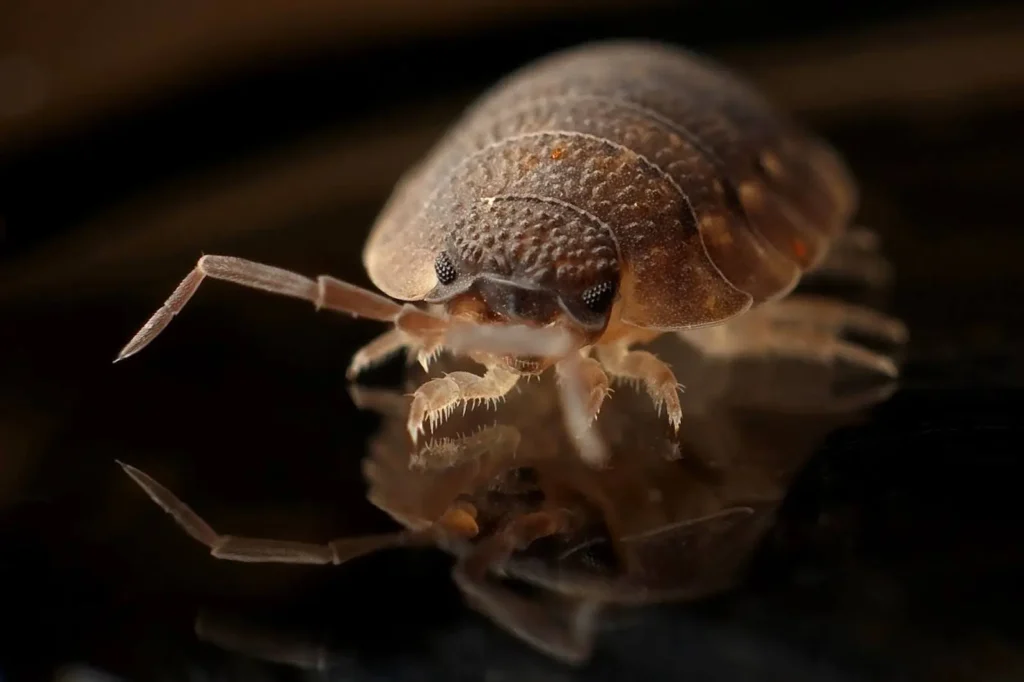How to Find Bed Bugs in Southern California
When you pull back your sheets to hop into bed, the last thing you want to see is a colony of bed bugs. California is home to gorgeous sunny days, sprawling natural landscapes, and plenty of tourism opportunities. Unfortunately, that means it’s also a hotspot for pests, including the infamous bed bug.
You don’t have to be in a questionable hotel room to encounter one; bed bugs hide in dark spots and beds worldwide. But for those living in Southern California, where conditions can encourage pests to reproduce quickly, spotting a problem early is crucial.
Key Takeaways
- Bed bugs are small, wingless pests that are shaped like ovals and have a reddish-brown appearance.
- Bed bugs feed on human and animal blood while we sleep, which means they’re usually found in or around beds.
- Signs of bed bugs to watch for include dark spots caused by blood stains or excrement, shed skins, bed bug eggs, and live bugs.
- You can prevent a bed bug infestation by keeping your home clean and limiting the chances of bed bugs traveling with you. Elimination usually involves the same sort of tactics, but you may need to consult a pest control professional for specific advice.
– – –
🐜 Get bed bug control in Sacramento County or San Diego County
Bed bug infestations will not go away on their own
Contact Us Now To Get Rid Of Them
– – –
Bed Bugs: A Quick Breakdown

A close-up of an adult bed bug. Credit: Pixabay
Bed bugs are tiny, oval-shaped, and wingless insects that feed on the blood of people and animals. Their reddish-brown bodies can be difficult to spot with the naked eye — adult bed bugs are only about the size of an apple seed! These pests may be small, but they have a massive impact on your home.
There is some good news: despite the fact that bed bugs can wreak havoc throughout their life cycle, they’re not known to spread disease.
Most people have little to no reaction to a bed bug bite. The worst consequence you’ll likely face is a serious allergic reaction, which is highly treatable with prompt medical care. But that doesn’t mean you shouldn’t take bed bugs seriously.
They can go a while without a blood meal, and they may reproduce and spread rapidly. Even if you can’t see them, bed bugs may be causing destruction that affects how you live.
Where Should I Look for Bed Bugs?
Bed bugs live all around the world. They set up shop in five-star hotels just like they do in small, old motels; a bed bug doesn’t choose where to live based on cleanliness. But a messier space can create more hiding places for these pesky pests. So, when you set out to look for bed bugs, make sure you pay close attention to cracks, crevices, and dark spots where bugs may conceal themselves.
These pests can sneakily enter your home by hitching a ride on your belongings when you’re out and about. So, since they live nearly everywhere, it’s especially important to look for bed bugs when traveling.
This is particularly true because bed bug infestations usually occur near areas where people sleep, like hotel rooms, apartments, cruise ships, trains, etc.
Look for bed bugs in common hiding spots like:
- Seams of mattresses
- Box springs
- Bed frames
- headboards and baseboards
- Under loose wallpaper
- In drawer joints or crevices
- In the seams of chairs, couches, cushions, curtains, etc.
- In electrical appliances
- The junctions where walls and ceilings meet
Remember, bed bugs need to feed on human and animal blood to survive. As a result, they tend to live within just eight feet of where people sleep. Bed bugs can scurry around, but they can’t fly — that makes it unlikely that they’ll be able to travel more than 100 feet in a single night.
What Should I Be Looking Out For?
Other than small creepy crawlies, what should you look for to identify a bed bug infestation? Some hallmark signs of bed bugs can clue you into a growing pest problem. Watch for these classic cues to identify bed bugs in your home or anywhere else you might sleep:
- Bite Marks: If bed bugs are living in your home, you might notice bite marks on the face, neck, arms, hands, etc. It can take up to 14 days for signs like itching or swelling to show up. Bed bug bite marks look similar to those of mosquitoes or fleas. They cause a slightly inflamed and red bump that may itch or be irritating. These bite marks sometimes appear in a straight line.
- Sweet, Musty Odor: A strong and almost sickeningly sweet musty smell is a telltale sign that bed bugs might be living nearby.
- Bed Bug Exoskeletons: As bed bugs grow and molt, they shed exoskeletons they no longer need. You might see these nearly translucent exoskeletons on or near your bed.
- Rust-Colored Stains: Brownish-red spots on your bed sheets or mattress may be caused by crushed bed bugs. They can also stem from bed bug droppings or fecal spots.
- Bed Bug Eggs or Live Bed Bugs: You might spot tiny, pale yellow eggs and eggshells near your bed. Or, you may notice live adult bed bugs moving around on your sheets, mattress, or in hiding spots.
– – –
🐜 Get bed bug control in Sacramento County or San Diego County
Bed bug infestations will not go away on their own
Contact Us Now To Get Rid Of Them
– – –
Getting Rid of Bed Bugs
If you spot even a few signs of a bed bug infestation, don’t wait to take action. It’s better to address the problem early before it worsens, which may take only a few days or weeks.
You can use DIY methods or safe pesticides to squash the bed bug problem. As you look into how to get rid of bed bugs in your home, don’t forget that it’s never a bad idea to call in professional pest control services for help.
Natural Strategies
Making your home inhospitable to bed bugs is perhaps the best way to eliminate them for good. To do that, you’ll need to make sure you remove all existing bugs and make it impossible for new critters to show up. Use bed bug removal tips like these to get started:
- Minimize clutter and keep surfaces clean, especially in your bedroom(s). Move your bed away from walls or furniture to make it easy to tidy up and keep bugs from spreading.
- Use high heat to wash your sheets, pillowcases, blankets, etc., then place them in a hot dryer for at least 30 minutes. Freezing bed bugs is another popular method, but ensuring that your freezer (or wherever you’re placing the infested items) stays cold enough to get the job done can be tricky.
- Protect your bedding by using mattress and box spring covers — like those designed for dust mite control — and putting duct tape over any mattress seams or zippers.
- Vacuum thoroughly; make sure you hit your molding, windows, and floors every day. Also, take the time to vacuum the sides and seams of your mattresses, box springs, and furniture. Empty the vacuum immediately into a sealed container outside the home.
- Seal cracks and crevices, as well as any openings where pipes or wires come into your home.
Bed Bug Pesticides
While it may be tempting, don’t immediately reach for the bug spray as soon as you see signs of bed bugs. In many cases, pesticides aren’t the best solution to the problem. They might get rid of a current infestation without preventing one in the future. Plus, pesticides can be dangerous when used improperly.
If you’ve tried other methods to get rid of bed bugs and want to try out a pesticide, make sure you use one that’s registered by the Environmental Protection Agency. The pesticide should be made for indoor use and labeled to control bed bugs. Closely follow all instructions, and remove any children or pets from the space you plan to treat.
Bed Bug Prevention Tips
Bed bug prevention is usually far easier than bed bug extermination. Maintaining a tidy and clean home helps, but it’s not always enough to totally prevent bed bugs from showing up. Keep your home safe from these unwanted pests by being mindful when you bring items in and out of your home.
1. Travel safely and protect your belongings.
Choose lodging that has good reviews when it’s time to travel. When you stay in a hotel, room, house, etc., place your luggage on a suitcase stand, not the bed or the floor. Keep your luggage away from walls and furniture so that any existing bugs can’t hop on as you leave.
2. Wash all clothes, bedding, etc., after a trip.
Wash your clothes and any other belongings you took on your trip in hot water as soon as possible. Put them in the dryer on a hot cycle to kill any hidden bed bugs.
3. Inspect any new furniture or items you bring into your home.
Anytime you buy new furniture, especially upholstered furniture, take a second to thoroughly inspect its surface, cracks, and crevices for any signs of bed bugs. Be a good neighbor and check your items for pests before reselling them, too.
– – –
🐜 Get bed bug control in Sacramento County or San Diego County
Bed bug infestations will not go away on their own
Contact Us Now To Get Rid Of Them
– – –
Professional Bed Bug Control in Southern California
For severe infestations or bed bug problems that don’t respond to at-home treatment solutions, it’s likely best to consult a professional pest control company. Choose experts who are well-versed in managing bed bug infestations for the best results.
A professional can help you determine where the bugs are coming from and take action to get rid of them once and for all.



